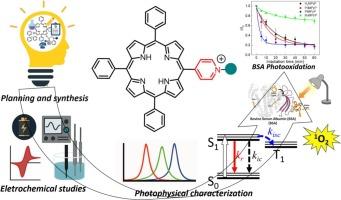Insights into bovine serum albumin (BSA) photooxidation mediated by mono-cationic porphyrins with Pd(II), Pt(II), and Ru(II) bipyridyl complexes
IF 4.7
3区 化学
Q2 CHEMISTRY, PHYSICAL
Journal of Photochemistry and Photobiology A-chemistry
Pub Date : 2025-09-16
DOI:10.1016/j.jphotochem.2025.116793
引用次数: 0
Abstract
Porphyrins are well-established photosensitizers for photodynamic therapy (PDT), and mono-cationic derivatives often display enhanced interactions with biological targets; however, their interactions with albumins remain insufficiently understood. In this study, we investigated the interaction between bovine serum albumin (BSA) and the photooxidative behavior (halogen-lamp irradiation) of a mono-cationic free-base porphyrin (H₂MPyP) and its Pd(II), Pt(II), and Ru(II) complexes, alongside comprehensive electrochemical, photophysical, and protein-binding characterizations. Compared with tetra-cationic analogues, the mono-cationic porphyrins were more efficient at populating the triplet state and generating singlet oxygen. Among them, H₂MPyP, PdMPyP, and PtMPyP exhibited high triplet quantum yields (ΦT ≈ 0.85), with H₂MPyP showing the highest singlet oxygen yield (ΦΔ = 0.70). All compounds promoted BSA photooxidation, with the overall efficiency following PtMPyP > PdMPyP > H₂MPyP > RuMPyP; notably, PtMPyP displayed the highest photodegradation rate constant (kpd = 0.286 min−1). Molecular docking located all porphyrins at site III (IB subdomain), stabilized by hydrophobic and π–cation interactions. No single descriptor (ΦΔ, lipophilicity, or affinity) alone accounted for reactivity, supporting an “exposure–affinity window”: productive protein photooxidation requires sufficient binding for colocalization with BSA but adequate exposure to O₂ near oxidizable residues. These findings show that metal coordination fine-tunes both excited-state deactivation and protein oxidation, offering actionable guidelines for designing next-generation PDT photosensitizers with improved efficiency and selectivity.

单阳离子卟啉与Pd(II)、Pt(II)和Ru(II)联吡啶配合物介导的牛血清白蛋白(BSA)光氧化研究
卟啉是公认的光动力疗法(PDT)的光敏剂,单阳离子衍生物通常与生物靶点表现出增强的相互作用;然而,它们与白蛋白的相互作用仍然不够清楚。在这项研究中,我们研究了牛血清白蛋白(BSA)与单阳离子游离基卟啉(H₂MPyP)及其Pd(II), Pt(II)和Ru(II)配合物的光氧化行为(卤素灯照射)之间的相互作用,以及全面的电化学,光物理和蛋白质结合表征。与四阳离子类似物相比,单阳离子卟啉更有效地填充三重态并产生单线态氧。其中,H₂MPyP、PdMPyP和PtMPyP具有较高的三态量子产率(ΦT≈0.85),其中H₂MPyP单线态氧产率最高(ΦΔ = 0.70)。所有化合物均促进BSA光氧化,总体效率依次为PtMPyP >; PdMPyP > H₂MPyP >;值得注意的是,PtMPyP的光降解速率常数最高(kpd = 0.286 min−1)。分子对接定位所有卟啉在III位(IB亚结构域),通过疏水和π -阳离子相互作用稳定。没有单一的描述符(ΦΔ,亲脂性或亲和力)单独说明反应性,支持“暴露-亲和力窗口”:生产蛋白质光氧化需要与BSA充分结合以共定位,但需要充分暴露于可氧化残基附近的O₂。这些发现表明,金属配位可以微调激发态失活和蛋白质氧化,为设计具有更高效率和选择性的下一代PDT光敏剂提供了可行的指导。
本文章由计算机程序翻译,如有差异,请以英文原文为准。
求助全文
约1分钟内获得全文
求助全文
来源期刊
CiteScore
7.90
自引率
7.00%
发文量
580
审稿时长
48 days
期刊介绍:
JPPA publishes the results of fundamental studies on all aspects of chemical phenomena induced by interactions between light and molecules/matter of all kinds.
All systems capable of being described at the molecular or integrated multimolecular level are appropriate for the journal. This includes all molecular chemical species as well as biomolecular, supramolecular, polymer and other macromolecular systems, as well as solid state photochemistry. In addition, the journal publishes studies of semiconductor and other photoactive organic and inorganic materials, photocatalysis (organic, inorganic, supramolecular and superconductor).
The scope includes condensed and gas phase photochemistry, as well as synchrotron radiation chemistry. A broad range of processes and techniques in photochemistry are covered such as light induced energy, electron and proton transfer; nonlinear photochemical behavior; mechanistic investigation of photochemical reactions and identification of the products of photochemical reactions; quantum yield determinations and measurements of rate constants for primary and secondary photochemical processes; steady-state and time-resolved emission, ultrafast spectroscopic methods, single molecule spectroscopy, time resolved X-ray diffraction, luminescence microscopy, and scattering spectroscopy applied to photochemistry. Papers in emerging and applied areas such as luminescent sensors, electroluminescence, solar energy conversion, atmospheric photochemistry, environmental remediation, and related photocatalytic chemistry are also welcome.

 求助内容:
求助内容: 应助结果提醒方式:
应助结果提醒方式:


